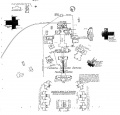Caswell Developmental Center
| Caswell Developmental Center | |
|---|---|
 | |
| Established | 1911 |
| Construction Began | 1912 |
| Opened | 1914 |
| Current Status | Active |
| Building Style | Cottage Plan |
| Location | Kinston, NC |
| Alternate Names |
|
History
Caswell Developmental Center has been serving people with mental retardation since it was established in 1911. It is the state’s oldest residential facility of its kind. What is now an over 300-acre campus with more than 100 buildings was the brainchild of LaGrange native, Dr. Ira May Hardy, in a paper he presented to the Seaboard Medical Society. Dr. Hardy had a child with mental retardation in his own family, according to early Caswell papers, and he realized the need for a school for the “feebleminded”. His vigorous lobbying, with the support of the medical community, moved the North Carolina General Assembly to authorize the school on March 4, 1911.
The cornerstone of the first building was laid on May 6, 1912. That building still stands in the center of campus. It has served as an administration building and classroom area. Currently, it houses part of the Communication Services and Dietary Departments. It was named in honor of Dr. Hardy, who served as the first superintendent of the North Carolina School for the Feebleminded.
A new superintendent, Dr. C. Banks McNairy of Lenoir, was at the helm on July 1, 1914 when 15 young women became the first admissions. Those first residents lived in a farm house (now called the Stroud House) standing on the 807 acres Kinston and Lenoir County offered state officials to use for the school. In less than a year, the school had 120 residents, 65 of them boys. Most of those first residents were able to help with housework or worked on the farm. The residents of the school were fed with the corn, potatoes, and other vegetables the school grew and the pigs and chickens it raised. The first young residents were given two and one-half hours of schooling each day, followed by “manual and industrial training” through their jobs around the school. According to records, eight residents with profound mental retardation spent the day with “recreation”.
In 1915, Dr. McNairy convinced the legislature to change the name of the facility to Caswell Training School. The name Caswell honors Revolutionary War leader Richard Caswell who lived in Lenoir County and served as the first governor of the independent state of North Carolina. The word “Training” was dropped from the school name in 1959 to distinguish Caswell from state schools for delinquent youth. The facility was named Caswell Center in 1963.
During much of its early existence Caswell Center operated on a shoestring budget. When both dormitories burned in the winter of 1918, 53 residents were sent home, others were sent to Dorothea Dix Hospital in Raleigh, and there was some question whether the school would survive. With an appropriation here and a bond issue there, new buildings sprouted on campus. Before groundbreaking ceremonies were held for each dormitory, the school had a list of residents waiting to move in. Because medical research into the causes of mental retardation was in its infancy, many people who would not be considered for admission today were admitted. Unwed mothers, juvenile offenders, persons with multiple handicapping conditions, and children with mental retardation, slept side by side in massive dormitories filled to overflowing with cots.
Caswell’s census reached 2,000 before other state facilities were opened to serve people with mental retardation. With sister institutions in Goldsboro, Butner, Morganton and Black Mountain, Caswell today serves citizens in the eastern region of the state. It is an agency of the Department of Health and Human Services in the Division of Mental Health, Developmental Disabilities and Substance Abuse Services. Caswell continues to have ties to nearly all 100 counties because some older individuals who had been at Caswell since childhood preferred not to transfer as new facilities opened in their home regions. Caswell Center is now home to approximately 430 individuals whose average age is 56 years.
When Dr. Hardy proposed Caswell Center, his emphasis was on medical treatment. In 1976, Caswell’s first administrator with a doctorate in education, rather than medicine, was hired. The chief administrator is now called the director rather than the superintendent.
Programs today are designed to meet the needs of individuals. Some areas on campus provide arts and crafts classes, music therapy, sensory stimulation activities and off-campus outings as suitable. Psychological counseling and creative expressions are also provided for individual needs. Children are no longer admitted to Caswell Center unless the services they need are not available at home or in the community. An individual is not placed at Caswell for life. Caswell Center is not seen as a place to shelter people with mental retardation. Individuals are admitted for a specific length of time to acquire services that will allow them to return home to enjoy life in the least restrictive setting possible.
Off-campus programs support services to people with mental retardation in their home communities. With training and encouragement from Caswell psychologists, physical and occupational therapists, speech clinicians, and others, parents can receive the support they need to care for their family members at home. Caswell Center staff support group homes and other community agencies by providing consultations and technical assistance. These services are provided as a “safety net” when necessary services are not available in their home counties.

